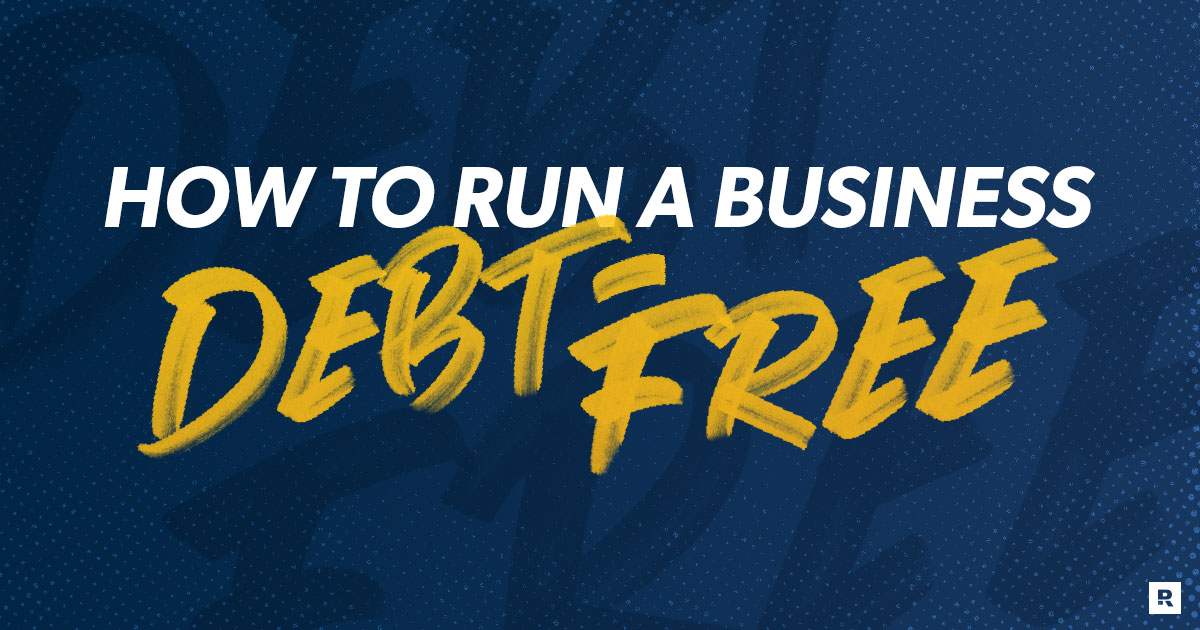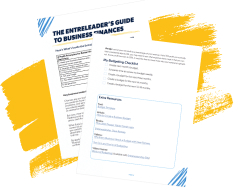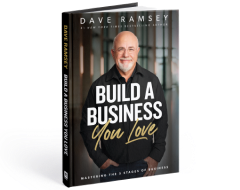
Key Takeaways
- Plan your budget on paper, on purpose before each month begins. A budget tells your money where to go instead of wondering where it went. Pair it with a profit and loss statement for a full financial picture.
- Live on less than you make. Don’t fall for the tax write-off trap. If you don’t need it, can’t afford it, or won’t make money from it—skip it.
- Don’t borrow money. Debt ties up your cash and increases risk. No once-in-a-lifetime opportunity is worth that. Stay within your means.
- Avoid the vicious, negative cash-flow cycle. Debt and unpaid taxes lead to desperate deals. Stay ahead of cash flow so you don’t become a statistic of businesses that fail.
- Make a three- to five-year plan to get rid of any debt you have. Use your profits to pay off debt, smallest to largest. The sooner you’re debt-free, the sooner you keep what you earn.
- Save money. Cash savings give you options. You’ll be able to handle emergencies, grow your business, and jump on big opportunities without debt.
- Be generous. Debt-free businesses can give freely. Whether it’s bonuses, customer perks or helping a neighbor, generosity fuels success.
True or false: The only way to start and run a small business is with debt.
The answer is false. But if you’re like a lot of other business owners, you might have trouble believing you don’t need debt to run a business. The truth is, you can’t run a business if you’re broke. And if your business is in debt, you run a higher risk of going broke when the next storm hits (looking at you, inflation, recessions and pandemics).
Now for a happier truth: You can learn how to run a business debt-free. Let’s walk through the tips for building a financially strong company so you’ll be able to pour your profits back into growing your business.
What Is a Debt-Free Business?
A debt-free business operates without creditors. There’s nothing complicated about it: no loans, no credit cards and no lines of credit.
To understand how a debt-free business sets you up to win, look no further than the classic fable The Three Little Pigs (yes, really!). The hero of the story (spoiler alert) is the pig who built his house with bricks—not straw or sticks. In financial terms, those bricks translate to rock-solid cash. Watching the other little pigs cut corners so they could pocket more money and put out less effort probably wasn’t fun for brick-house pig. But when the big, bad wolf came, brick-house pig was the last swine standing. All the huffing and puffing in the world couldn’t shake him or his house.
Just like brick-house pig, you want a strong foundation for your business—and that means keeping it debt-free. When your business is debt-free and strong, you’re strong too. You can keep a clear head and rise above fear, panic and hysteria when bad things happen. Even better: You can take advantage of rock-bottom prices and amazing opportunities as others cut their losses. Not a hair is out of place on your chinny chin chin.
Don't Let Your Numbers Intimidate You
With the EntreLeader’s Guide to Business Finances, you can grow your profits without debt—even if numbers aren’t your thing.
Financial Advice for Small Businesses
The bottom line of The Three Little Pigs is this: Hard work pays off. Yes, the extra effort might be rough at first, but it’s totally worth it. You’ve got this! As you strap in for the long haul of running your business debt-free, try out this financial advice for small businesses to get started:
You probably thought running a business sounded fun—until you realized it would actually run you. Discover the EntreLeadership System—the small-business road map that takes the guesswork out of growth.
1. Plan your budget on paper, on purpose before each month begins. A budget is how you tell your money where to go instead of wondering where it went. Using a budget (to look forward) and a profit and loss statement (to look backward) gives you the full picture of what’s happening financially in your business.
Related article: How to Create a Business Budget
2. Live on less than you make. Some of the worst financial advice you can get is to make a luxury purchase you can’t afford in the name of a tax write-off. It’s bad business to spend $10,000 so you can save $2,500 in taxes. Unless you truly need the item for your business, you have the cash to pay for it, and you’ll make money by buying it, just say no.
Related article: 23 Common Tax Deductions for Small-Business Owners
3. Don’t borrow money. That’s called debt, and it’s the opposite of living in moderation and staying within your means. How much debt is acceptable in business? None. Sure, it’s tempting to borrow money for what seems like a once-in-a-lifetime or foolproof opportunity—but don’t do it. When you have debt, you drastically increase your financial risk, and just one bad deal could even put you out of business. If you’ve owed the bank money before, you understand that the borrower is slave to the lender.
Related article: 6 Small-Business Money Mistakes (and How to Avoid Them
Your Road Map to Grow Your Business
Dave Ramsey’s new book Build a Business You Love is now available for purchase! This book will walk you through the same proven system Dave Ramsey used to build Ramsey Solutions from a card table in his living room to a $250 million company.
4. Avoid the vicious, negative cash-flow cycle. Cash-flow problems quickly spiral out of control when you borrow money you can’t make payments on or don’t set aside enough money to pay your quarterly taxes. You end up making more bad business deals just to keep the bank or IRS off your back. That’s why cash-flow problems are the main reason at least 51% of businesses fail in the first five years.1
5. Make a three to five year plan to get rid of any debt you have. Use a percentage of your monthly profits to pay off your debts from smallest to largest. Following a budget will help you stay on track to pay off debt.
6. Save money. The money you put away is called retained earnings, and it’s crucial for helping your business survive and prosper. Your retained earnings can go toward emergencies, planned purchases and investments in your business. And when you have cash savings, you can capitalize on those once-in-a-lifetime opportunities we mentioned earlier. That’s known as having margin (aka the power to jump on opportunities when they come).
7. Be generous. This is where the fun really starts. Even when your budget is tight and you’re working hard to get or stay out of debt, think of creative ways to share your products, services and profits. Give to your team members, your clients and even your neighbor one building over. Giving keeps you energized and encourages a more positive company culture. It might even inspire others to pay your generosity forward!
Related article: What Is Company Culture?
Myths About Business Debt (and How to Bust Them)
Okay, now you have a solid set of principles to keep your business in the black (aka debt-free). But you may still have some nagging doubts that could trip you up. We get it. So let’s debunk some myths a lot of business owners struggle with and discover the truths that will really set you free—debt-free.
Myth 1: I need to borrow money to start or expand my business. Can I run a business without debt?
Truth 1: You can run your business without debt. It just takes patience and the guts to do things differently (just like the brick-house pig). A lot of entrepreneurs wonder, How can I fund my business with no money? But the truth is, many small businesses start pretty small—with $5,000 or less.2
When you launch or expand your business gradually and move at the speed of cash, you lower your financial risk and minimize the impact from the mistakes you’ll make as you grow and learn. Moving at the speed of cash has another advantage too: It helps you pause and think. Using real money from your account activates the pain center in your brain so you’re more likely to question whether you really need to buy that fancy work truck and drive away with all the company debt that comes with it.
Myth 2: I need a line of credit to cover cash-flow fluctuations.
Truth 2: Cash-flow fluctuations are predictable when you use an accounting system. Say you have a lawn care or construction business, and you know business slumps in the winter. With good forecasting, budgeting and savings (there are those beautiful retained earnings again), you’ll be prepared for your off-season and can provide your own line of credit.
Myth 3: I need a credit card to travel and shop online.
Truth 3: A debit card can do everything a credit card can do—including give you the same fraud protection—without the risks of carryover balances and massive interest rates businesses in debt have to deal with. Sadly, 17% of new small businesses report using a credit card to finance their start up, not just make certain types of purchases.3 And 53% of all small businesses report using a credit card to finance their business.4 When you use your debit card instead, it helps you stay accountable to your budget. Win-win!
Myth 4: I can’t make large equipment or real estate purchases without using debt.
Truth 4: You can’t afford to make a large purchase until you slow down, think, plan and figure out the best way to grow your business. The following four options are the best ways to spend money on big-ticket items or services:
1. Pay cash (which may mean you have to wait while you save).
2. Rent the equipment or space (this saves you from monthly payments you can’t afford and from buying more than you need).
3. Outsource it (aka use other people’s equipment and resources). For example, if you’re not an expert in printing, let a printing company do it for you. Save the hassle and the money.
4. Buy used (which might mean tolerating the ugly and the old). It’s okay to be scrappy and make do with fewer bells and whistles while you’re getting out of debt or building your savings. Getting a great deal on some not-cute, paid-for furniture is better than losing your business because you can’t make payments on something prettier. Slow and steady wins the race.
What’s Next: Build Strong
Enough myths. Let’s drop a couple more truths.
Truth: The big, bad wolf is out there. He’s coming for your business—in the form of new competitors, craziness in the economy, or some other storm you won’t see coming.
Truth: Debt makes you weaker, not stronger. Remember: The borrower is slave to the lender.
The final (happier) truth is this: You can survive the unexpected by hustling to get and stay debt-free by following the principles above. Even if you started your business with company debt, it’s okay. You can become debt-free—one brick at a time.
Related article: EntreLeadership: What Are the 5 Stages of Business?
Need more encouragement for your debt-free journey? Check out The EntreLeader's Guide to Business Finances and grow your profits without debt—even if numbers aren’t your thing.


